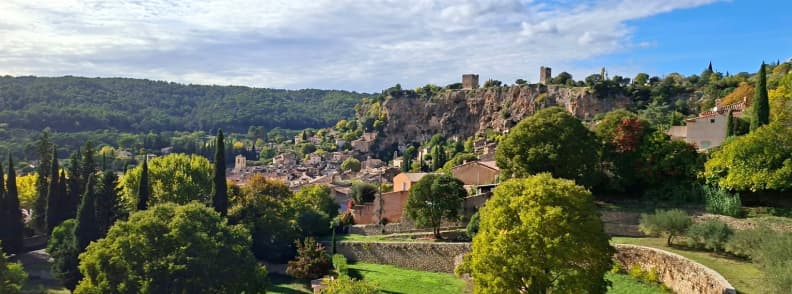After a frustrating stop in Sillans-la-Cascade that ended with blocked camper parking and a steep turn we didn’t dare try, we rolled into Cotignac late on a windy October afternoon. The drive through the Var felt endless after turning away from Sillans, where every parking space seemed designed to keep campers out. By the time we reached Cotignac France, the limestone cliffs glowed gold above tiled roofs. The mood shifted immediately. Sillans-la-Cascade had felt shut to campers. Cotignac felt open, calm, and quietly proud. Even before finding a place to park, I could tell this village had a different rhythm, slightly slower, warmer, and more generous to visitors.
Cotignac Provence sits in the heart of Provence Verte, between Draguignan and the Verdon canyon. About 2,200 people live here, tucked under Le Rocher, a striking 400-metre-long and 80-metre-high tuff cliff shaped over centuries by the Cassole River, which locals diverted in the 18th century.
Visit Cotignac Guide
The cliff shelters houses built into the rock and narrow alleys that climb toward old Saracen towers. Cotignac has held the Plus Beaux Villages de France label since 2022, an honour that matches its looks but not its attitude. This is still a lived-in, working village, not a museum.
This Cotignac travel guide is built on my own weekend experience: traveling by camper, parenting a toddler, and exploring without a fixed plan. I’ll show you how to visit Cotignac step by step, including where to park if you’re driving a large vehicle, what to expect on the cliff walk, how to reach the troglodyte caves, and where to find real food at fair prices.
You’ll see the market through local eyes, taste quince liqueur at the Fête du Coing, and climb to the sanctuary of Notre-Dame de Grâces or Saint-Joseph du Bessillon, two pilgrimage sites that give Cotignac Provence its soul. I include the small details I wish I’d known, from uneven camper spots to the best light on the cliffs.
If you’re planning to visit Cotignac or map a base in Cotignac Var, this guide blends personal insight with precise information. It covers the history behind the troglodyte village Provence, the story of the Cassole River, and why this cliff village Provence continues to draw travelers seeking beauty with substance. Whether you’re here for a day, a weekend, or a longer escape into Provence Verte Cotignac, you’ll find honest tips, practical advice, and lived experience. In other words, here’s everything you need to explore one of the most beautiful villages France with confidence and care.
Disclosure: Some of the links below are affiliate links. This means that at no extra cost to you, The Travel Bunny will earn a small commission if you click through and make a purchase. Thank you!
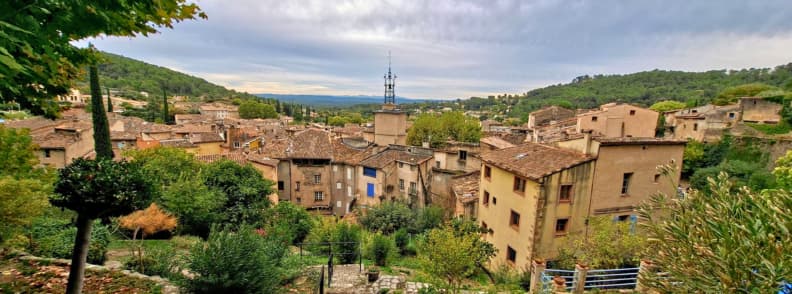
Getting to Cotignac France & Why We Skipped Sillans-la-Cascade
Getting to Cotignac is simple once you know what to expect. The village sits deep in Provence Verte, between Draguignan and the Verdon canyon, surrounded by vineyards, olive groves, and winding country roads. Driving to Cotignac is the best option, since there’s no direct train. Most travelers arrive by car or camper after landing at the nearest airport to Cotignac, Marseille, or Nice, both about two hours away.
The drive is easy and scenic, but if you plan to explore in a camper or van, you’ll want to understand parking restrictions in the smaller Provençal villages along the way. This is where our weekend started to unravel before Cotignac won us back.
Our Camper Start from Bagnols-en-Forêt
We set off from Bagnols-en-Forêt in our 7-metre camper, and we were well stocked after a stop at a commercial zone in Draguignan for groceries and Halloween candy. The plan was simple: visit Sillans-La-Cascade, hike the famous Sillans waterfall trail, spend the night near the village, and continue to Cotignac France the next day.
The drive through Provence was peaceful, and with the sun still high, we felt confident that parking near the falls would be as straightforward. After all, most camper France travel stops in rural areas are easily accessible outside peak season. What we didn’t know was that Sillans-la-Cascade parking would test every bit of patience we had.
Why We Moved On from Sillans-la-Cascade
By late afternoon, the charm of Sillans-la-Cascade had faded behind red and white “no campers” signs. Both Place du 8 Mai 1945 and Parking Cascade were closed to larger vehicles. The only remaining option, Parking du Village, technically allowed campers but came with a hidden obstacle. The easy descent had been blocked with a boulder (!), leaving only a broken stretch of road that dropped at a sharp 90-degree angle. We assessed it, took a deep breath, and turned around. Everything in Sillans-la-Cascade felt designed to keep campers away. After wasting an hour circling, we decided to skip it altogether.
Large vehicles should avoid Sillans-la-Cascade parking. Base instead in Cotignac, which welcomes campers and offers several safe spots outside the village. You can still do the Sillans waterfall hike as a day trip once you’re settled. For those coming from Marseille, Nice, or Aix, aim to reach Cotignac by camper before evening to secure a level space. It’s the smartest move for anyone doing vanlife Provence or planning a slow journey through southern France.
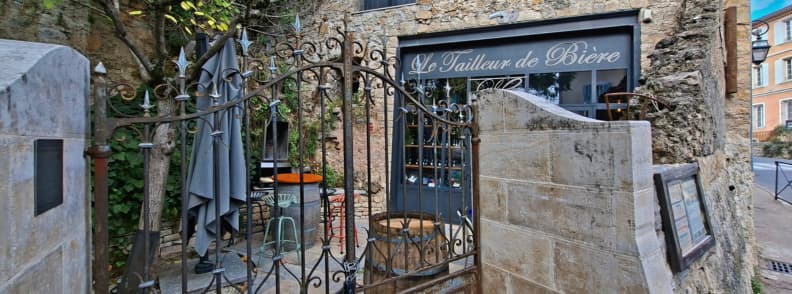
First Impressions After Arriving in Cotignac by Camper
The moment we reached Cotignac France, the atmosphere changed completely. After wasting so much time navigating tight turns and closed gates at Sillans, our Provence weekend trip finally felt like it was heading in the right direction. The first glimpse I caught was of the cliffs above the village bathed in the golden light of the afternoon sun, and I understood why it was named one of the Plus Beaux Villages de France in 2022. Arriving in Cotignac by camper van was a relief, a feeling shared by anyone who has ever driven through Provence searching for a proper and level place to park.
Parking in Cotignac
Finding parking in Cotignac Var takes patience and a bit of insider knowledge. The village has several official lots, but many are small and/or have a 2 m height limit, which excludes most campers. Parking 634 Lauron, a large gravel lot near the lower entrance to the village, is usually the best option. It was supposed to be closed until 24 October, but it remained closed, for a reason we had yet to find out at the time.
Another convenient choice is the Tourism Office parking, but it’s also restricted to vehicles under two metres high. It would be perfect otherwise. It’s a bit out of the way, level, and surrounded by trees.
We finally found our spot at 867 Chemin de la Colle, listed on Park4Night Cotignac. It sits about fifteen minutes from the village on foot, in a green area near the road and some houses. There were no signs against overnight stays and no checks during our stay.
We parked as straight as possible, though the ground was slightly uneven. Our camper leaned enough that our feet were a little higher than our heads while sleeping, but after the chaos in Sillans, we didn’t care.
Although by the road, traffic isn’t heavy on out-of-season weekends, so it was pretty silent, the air smelled of pine and woodsmoke, and for the first time that day, we could relax. It felt like a small reward for pushing through.
Cotignac Local Tip: Arrive before 5 PM to find a space, especially on weekends or during events like the Fête du Coing. Village lots fill up quickly once local visitors arrive for dinner or evening concerts.
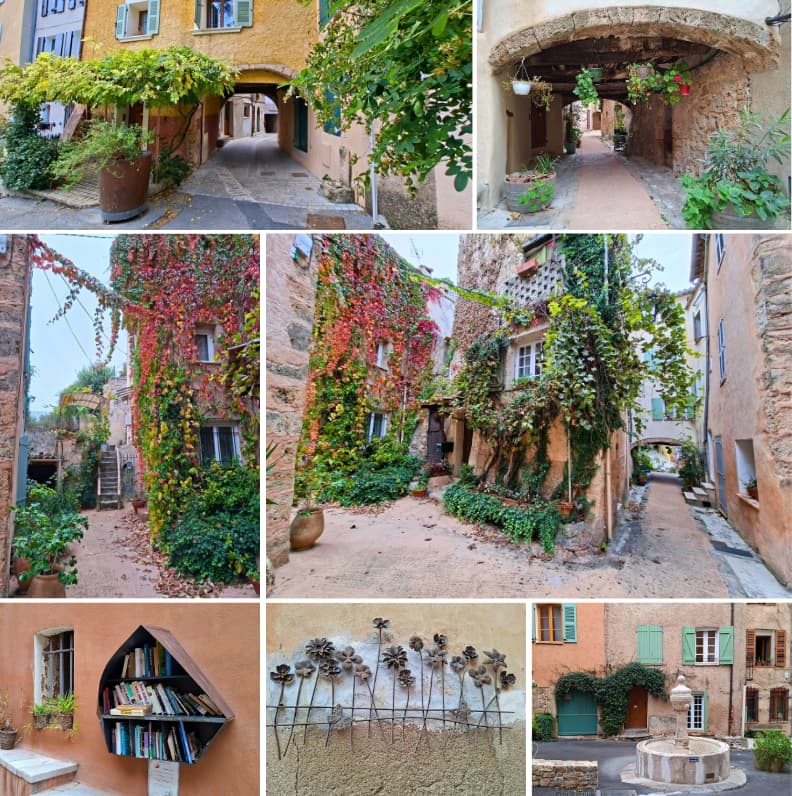
Our Saturday Visit to Cotignac. Fête du Coing Preparations & Village Walk
Arriving in autumn Provence means shorter days, golden light, and the kind of calm that makes small villages feel even more alive. Cotignac France was preparing for its famous Fête du Coing, the annual quince festival Provence that fills the lanes every October with stalls, music, and the scent of simmering fruit.
For the 2025 edition, scheduled on 26-27 October, the village was already buzzing on Saturday evening. Cours Gambetta was lined with folding tables, tents, and stacks of wooden crates ready for the next day’s Cotignac market. Volunteers carried boxes while shopkeepers hung banners, creating a quiet anticipation that only small Provençal towns manage to build.
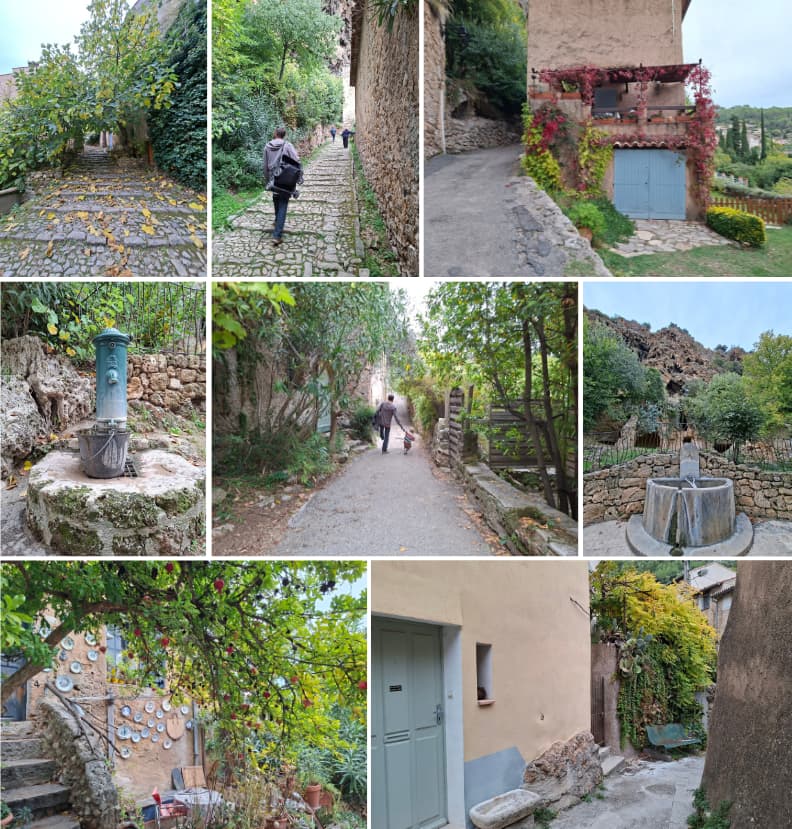
Wandering Under the Cotignac Rocher
We walked through the lanes under the tuff cliff as the sunlight dropped lower on the limestone wall. The stone glowed orange, the air cooled, and every turn revealed a new poster announcing the Fête du Coing Cotignac. Families lingered outside cafés, and kids ran between tables set for Sunday’s feast. The mood felt festive but relaxed, like the village was collectively taking a deep breath before the big day. This is what Provence autumn looks like away from the coast, with real people preparing for real traditions.
Dreaming of Vin Blanc Chaud au Coing
In front of Bar Le Marigny, Mathieu spotted a sign advertising vin blanc chaud au coing, a hot spiced white wine made with local quince. The bartender smiled and explained it was still brewing and wouldn’t be ready until the next day. Even without tasting it, the moment summed up Cotignac autumn market life, all patient, simple, and focused on doing things properly.
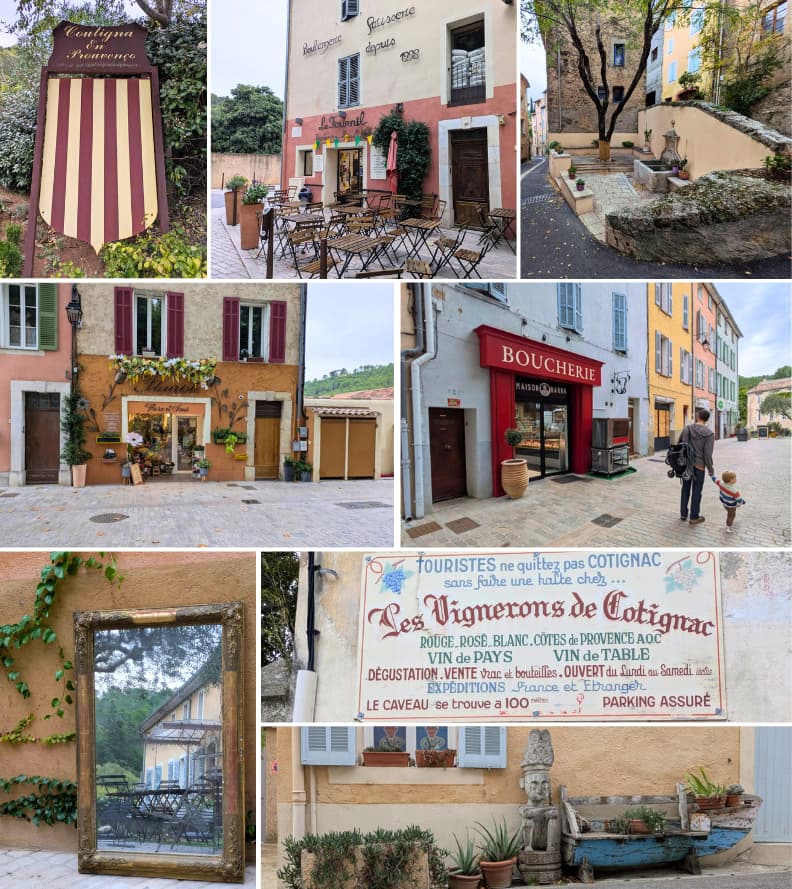
Evening in the Camper
When darkness approached, we made our way back to the camper parked just outside the village. Dinner was quick and quiet, more of an apéro dinatoire with stuff we bought in Draguignan.
Willy’s bedtime is a small ritual of its own. After outgrowing the baby bed we got for the camper, he now sleeps in a toddler tent on top of the salon couches, turned into a second bed for the night, while we settled in the rear bed. Mathieu laughs about it, saying he goes camping in the camper.
For us, it was an important moment, because for the first time, he fell asleep without Papa next to his tent. Just knowing we were near was enough. And we had time to watch an episode of Wayward on Netflix with headphones, before turning in for the night as well.
Cotignac Travel Tip: If you visit during the Fête du Coing Cotignac, park outside the center. Most central lots become event zones or vendor areas. The walk into town is short and peaceful, and you’ll avoid getting blocked by market closures.
That night, Cotignac felt like the perfect base for slow travel in Provence Verte. The festival banners moved softly in the wind, and the cliff stood above everything, silent and golden under the streetlights.
Sunday Morning Hiking & Visiting Cotignac Troglodyte Caves
Morning in Cotignac France started quietly. The market square was already alive, but most visitors were still preparing for the Fête du Coing. For us, the plan was to hike before the crowds and explore the troglodyte caves Cotignac, a site that defines this cliff village Provence. Le Rocher Cotignac, the rock wall, rises directly above the houses, hiding ancient rooms, tunnels, and towers cut into the tuff. Exploring them feels like walking through the layers of the village’s past.
Morning Start
We had breakfast in the camper, windows open to the sound of church bells. Willy ate while watching the first cars struggling to park for the festival. The time we took the baby carrier, and filled our water bottles. We dressed Willy warmer than us, because he wasn’t going to move as much.
The Cotignac troglodyte caves open at 9.30 AM, so we had some time to stretch our legs first. Mornings in Provence Verte are crisp in autumn, perfect for walking.
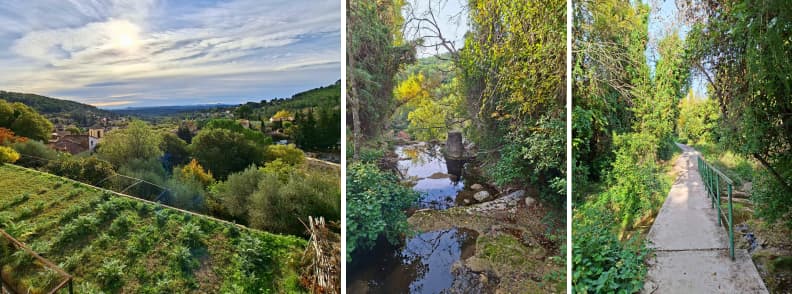
First Attempt to See the Cascade Cassole / Gouffre de Cotignac
From the Mairie de Cotignac, we followed a sign for the Cotignac cascade, also called the Cascade Cassole or Gouffre de Cotignac. The trail winds up and outside the town, making me think of a walk we did in Moustiers-Sainte-Marie. Then, the path turns muddy as the trees get thicker, arriving at a bridge at the top of the falls, where the Cassole River drops down the cliff. We couldn’t see any path to the bottom, and there weren’t any signs around either. We could hear the sound of water falling.
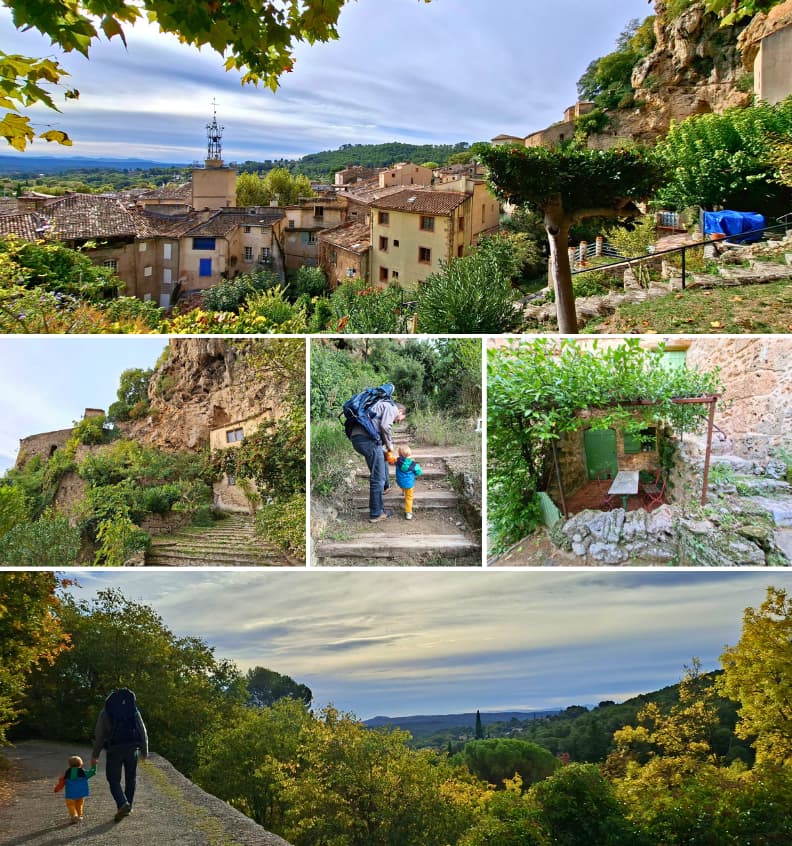
We turned back to the village and continued with the Balade du Rocher, the Cotignac cliff hike that runs above the old dwellings and connects with the Saracen towers. The path was dry and safe, though uneven in parts. It offered some of the best views over the tiled rooftops and the green plain below.
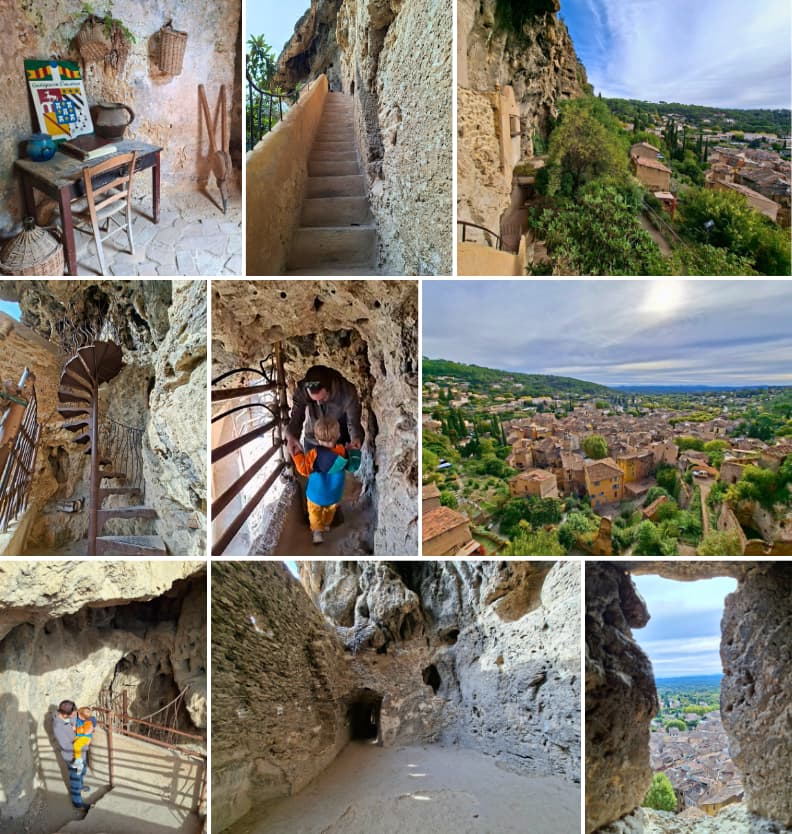
Visiting the Cotignac Caves
By mid-morning, we reached the ticket booth at Le Rocher Cotignac. Entry costs €2.50 per adult, free for children, payable by card or cash. The Cotignac caves hours vary by season, with shorter opening times in winter. We were among the first visitors of the day, which made it easier to explore the narrow passages at our own pace and enjoy the quiet of the cliff before the crowds arrived.
Inside, the light shifted constantly as we climbed the narrow stone stairs. A couple of chambers opened into rooms carved directly from the rock, their small windows cut through the limestone to bring in sunlight. Some rooms still showed traces of lime plaster used to fight humidity, while others led to terraces where villagers once grew herbs or kept watch. The view from the lookout balcony stretched over the valley and rooftops below, proof of how this cliff once served as a natural fortress.
Carrying a toddler through the Cotignac troglodyte caves made the visit more interesting. The stairs were steep and sometimes spiraled tightly, so Mathieu carried Willy part of the way while I managed the carrier. Near the top, we left the carrier by the steps and let him walk on his own for a few minutes. On the way down, Mathieu carried him again while I followed with the empty gear. Railings helped in the narrow sections, and the cool, damp air made the climb surprisingly comfortable despite the incline.
The caves themselves tell the story of Cotignac’s origin. Long before the village we know today, the Cassole River cascaded here, carving the limestone into hollows. As the water deposited tuff over thousands of years, the cliff formed the overhangs that later became natural shelters. People began occupying these cavities during the early Middle Ages. Around the year 1000, a fortified hamlet developed on the plateau of Saint-Martin above the cliff, and by 1032, a castrum stood nearby. The small castle was 24 metres long, 8 meters wide, and 14 meters high. When invasions swept through Provence after the Roman era, villagers moved downhill to live beneath the rock, adapting the caves for safety and survival.
These troglodyte fortifications include two Saracen towers, built in the 12th century without ground-level entry points so guards could observe from above. History suggests that secret passages once connected the towers to the inner cliff. The caves protected residents, their livestock, and their food supplies during attacks. One was said to be large enough to shelter every inhabitant and their animals at once. Inside, you can still see traces of human work, with niches, old chimneys, feeding troughs, and remains of pigeonholes. Some caves even became workshops, as the cliff served as a quarry until the late 19th century.
By the 1300s, life around Le Rocher Cotignac flourished. The Hospice de la Charité opened in 1314, and mills were built against the cliff, powered by diverted water from the Cassole. In 1897, Cotignac installed a small hydroelectric plant, becoming one of the first villages in the region to have electricity. Over time, the number and use of the caves changed, but their role as a shelter and resource shaped the village’s identity.
The word troglodyte comes from ancient Greek, meaning one who enters a hole. Ancient historians like Herodotus, Diodorus of Sicily, and Pliny the Elder used it to describe nomadic desert peoples who lived in natural rock shelters. In Cotignac, the term took on a more practical meaning, referring to people who built their homes within stone, adapting nature instead of fighting it.
The Cotignac troglodyte caves visit is short, around thirty minutes, but every step reveals layers of history and geology. Standing inside the cliff, surrounded by centuries of human effort, you’ll get a sense of how deeply people here have lived with their landscape, not above it, but within it. It’s an experience that stays with you long after you leave the rock face and return to the sunlit square below.
Cotignac Balade du Rocher Tips: Remove children from carriers for the descent. The ceilings are low, and the steps can be slippery after rain. Flat shoes with grip make the Cotignac cliff hike safer, especially when carrying a small child.
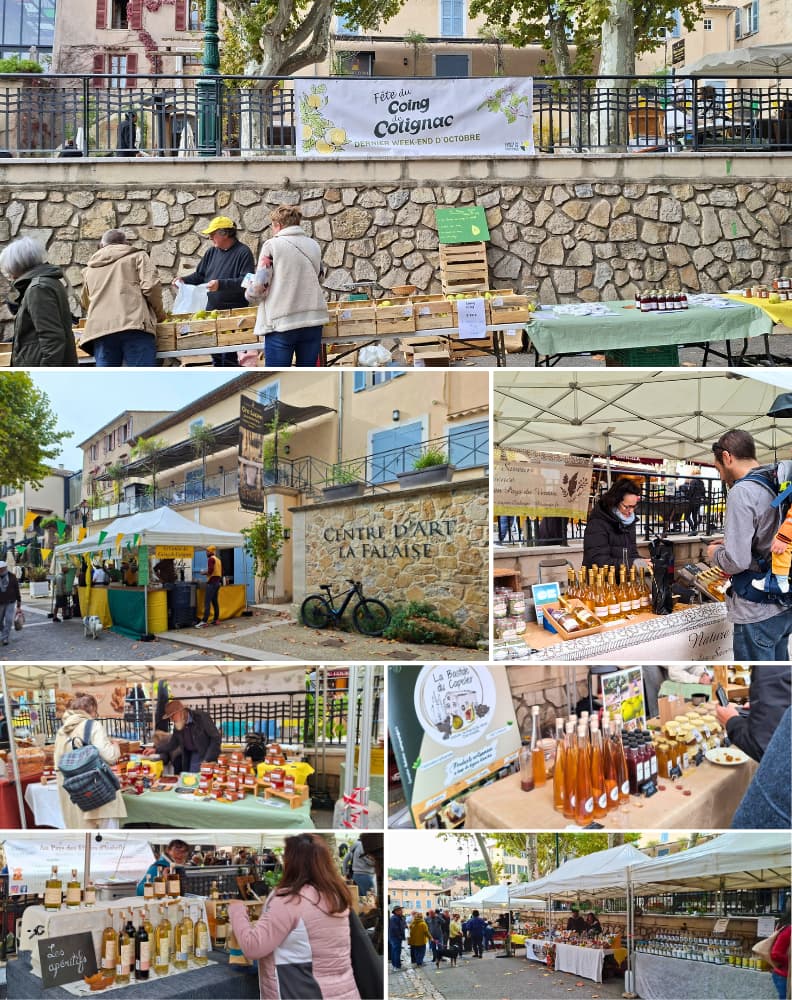
Market & Village Life During the Fête du Coing
Sunday morning in Cotignac France, felt like walking into a postcard of autumn Provence. The Fête du Coing is the highlight of the season here, turning the village into a mix of market, festival, and family reunion. For locals, it is a celebration of everything grown or made from the quince, the fruit that symbolizes patience and warmth in this part of Provence.
Cotignac Market Details
The Cotignac market for the festival spreads across the square in front of the mairie and along Cours Gambetta. There were jars of jam, bottles of liqueur, pastries, and trays of fresh fruit. We bought a bottle of Coing Nature et Saveurs digestif from Artignosc-sur-Verdon for around twelve or fourteen euros. It came in a simple glass bottle and smelled sweet and slightly floral. The vendor poured a small sample into a small metal cup for us to taste and smiled proudly as she spoke to us about it.
We wanted to try the pâtes flambées. We passed by the big cheese wheels carved out to mix the hot pasta inside, but they weren’t yet ready at that time. We also searched for the promised mulled white wine with quince at the pop-up Resto du Coing, but the sign had been crossed out that morning.
Kids’ Activities
In front of the mairie, the organisers had set up a wooden play area for children. It looked amazing, but wasn’t a great fit for our toddler. The games were either meant for older kids with some knowledge of cooperative play or for little ones still crawling on a playmat, so we watched for a bit and then moved on.
Cotignac Family Tip: For families visiting at other times of year, there’s a permanent playground on the path that leads to the Sanctuary, which might make a better stop for small children.
Feeding our son during the Fête du Coing was a small challenge. Although he eats the same meals as us, most market food that interested us seemed too salty for him, and the Spar grocery in the village had very few baby-friendly options. And while I know the Good Goût range is expensive, Spar really upped the cost, in my opinion.
We ended up returning to the camper so he could eat there. It took longer than we expected, so we stayed for our own lunch as well. The quiet break in the camper turned out to be a good pause before heading out again to explore more of Cotignac.
Fête du Coing Tip: Bring toddler snacks and a spoon when visiting markets in Provence Verte. Local markets like the Fête du Coing Cotignac focus on traditional food, not baby meals, so it’s easier to plan ahead if you’re visiting Cotignac with small kids.
Instead, we went to Bar Le Marigny, which had been infusing vin blanc chaud au coing overnight. For four euros, we received steaming cups fragrant with spices and fruit. The warm sweetness felt perfect in the cool wind of October.
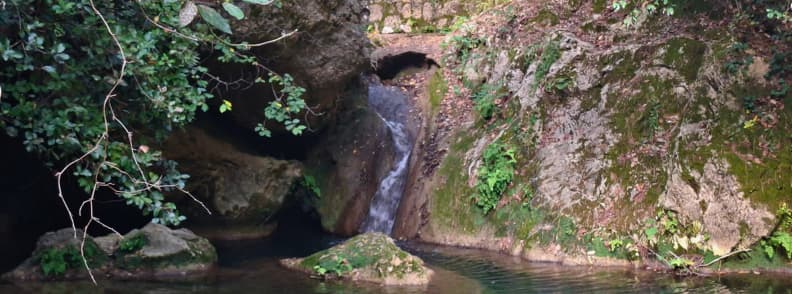
Second Attempt to Visit Cascade Cassole / Gouffre de Cotignac
After lunch, we decided to try again to see the Cotignac cascade, this time by following the path that starts next to the Police Municipale. The trail runs along the river, shaded and peaceful, with benches and picnic tables near the start. It looked promising, easier to follow, and more open than the one behind the mairie. We hoped this would finally bring us down to the base of the falls.
For a while, it was beautiful. Then the path along the river ended abruptly. A few large trees had fallen across it, and just beyond, red-and-white tape blocked access.
William had fallen asleep, and to keep him asleep, we had to keep walking. So we decided to go back and hike up to the Cotignac Sanctuary.
The Sanctuary of Notre-Dame de Grâces
Visiting Notre-Dame de Grâces Cotignac is a quiet shift from the lively village streets below. The sanctuary sits on a hill covered in cypress and pine trees, overlooking vineyards and the cliffs that shape Cotignac Provence. It’s one of the most meaningful stops in this part of Provence Verte, not only for believers but for anyone interested in the island’s spiritual and cultural past. The site has drawn pilgrims for centuries, ever since the reported apparition of the Virgin Mary in 1519, followed later by a visit from Louis XIV, who left an ex-voto plaque in gratitude.
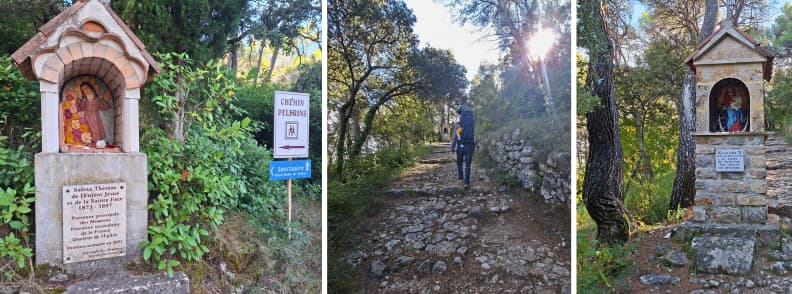
Getting to the Shrine of Our Lady of Graces
We started our walk up the hill in the early afternoon, taking the road beside the Police Municipale. The route climbs by houses before joining the main staircase to the church. It’s a bit steep but shaded. We preferred this way to the road, which has no sidewalk and steady traffic. The trail isn’t stroller-friendly, so we carried our son in his baby carrier. He stayed asleep, his head resting on his hands, while we climbed the stairs in silence. The breeze smelled faintly of pine resin and dry earth, and the village bells rang below us.
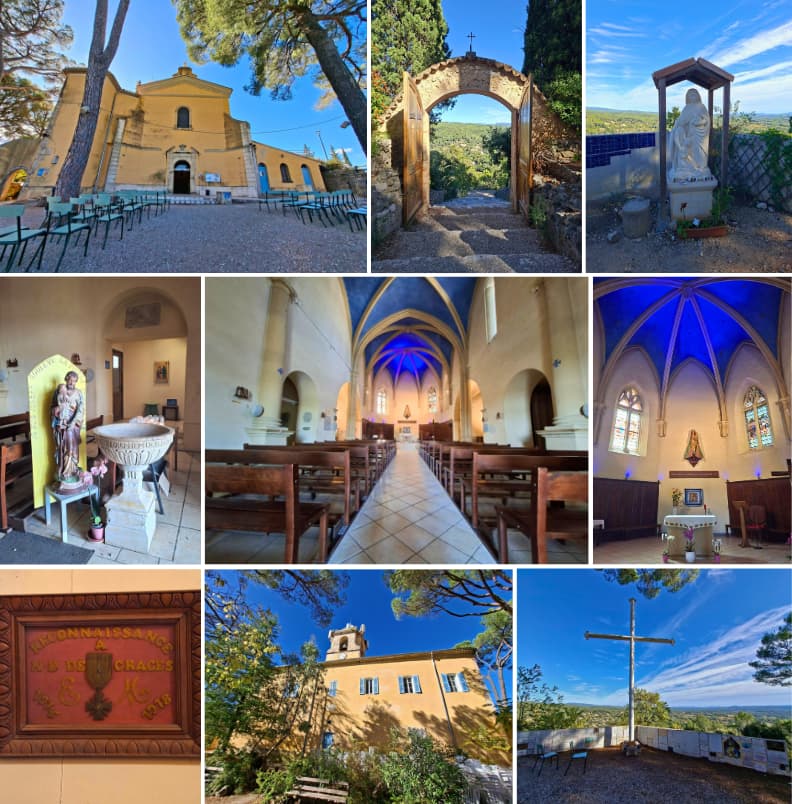
Inside the Shrine of Our Lady of Graces
The sanctuary was calm when we arrived, and there was barely anyone in sight. Inside, the ceiling caught my eye first. It’s painted in deep shades of blue, and there are stars above the Virgin’s statue. Along the walls hung hundreds of ex-voto plaques and military medals, each one a note of gratitude or remembrance from those who believed they had received help here.
Seeing the small Louis XIV ex-voto, I thought about how many stories had passed through this place. We stood there a while, not talking. I’m not a regular churchgoer, but this visit felt different. After all the blocked roads and parking frustrations, somehow we had ended up here. Maybe it was a coincidence. Or maybe, as people say, some places pull you in for a reason. After years of trying to start a family, we finally had our son. And after all the troubles of starting our family weekend, we finally ended up here, in a place where families come to pray for a child and say thanks for the one(s) they were given (including Louis XIV).
Cotignac Travel Tip: The Notre-Dame de Grâces Cotignac sanctuary is open daily, but the best time to visit is late morning, when it’s not crowded. Bring a scarf or light jacket for modesty, as locals dress respectfully inside.
Just beyond the sanctuary lies Saint Joseph du Bessillon, another pilgrimage Cotignac site linked to an apparition in 1660. Both sanctuaries form part of the same spiritual route and reflect the deep religious heritage of Provence, a tradition that continues to shape local life even for those who simply come to admire the view.
Afternoon Surprise. Equestrian Show at the Fête du Coing
By early afternoon, Cotignac France was lively again. The wind had picked up, and banners from the Fête du Coing fluttered along Cours Gambetta. We knew from the posters that there would be an equestrian show at 14 h, so we planned our hikes and our son’s nap around it. After the Sanctuary visit, we walked back toward the market, arriving right on time.
But the posters with the Fête du Coing programme hadn’t mentioned any performance location, so nobody seemed sure. We asked at Resto du Coing, where the staff smiled and pointed us toward Parking 634 Lauron Cotignac, the same lot that had been closed the day before when we first arrived.
Discovering the Show
The spectacle équestre by the Association Chevaux de Prestige was about to start when we reached the lot. Riders in Mongolian costumes or wearing the yellow and green of the quince festival guided beautiful horses in tight circles around the tall plane trees, the sound of hooves pounding the ground strongly.
Families stood around the edges, children sitting on the barriers or on shoulders, everyone bundled in jackets against the cold. The horses moved with a rhythm that felt both rehearsed and effortless, the kind of show that small Provençal festivals still do with pride.
Watching with Our Toddler
Our son watched wide-eyed, silent for nearly forty minutes, completely absorbed. Every time the horses trotted past, he laughed and even clapped sometimes. It was the kind of happiness that makes family travel worthwhile. The wind got stronger as the show went on, though, and our fingers grew cold.
The parade that was supposed to follow would likely continue along Cours Gambetta, but we decided to skip it. Instead, we stopped at Bar Le Marigny to warm up with their fabulous vin blanc chaud au coing that brewed all night.
I ordered our mulled wine to go. Then, I found out that they don’t accept cards for payments under 15 euros. And our two glasses of mulled wine were only 8 euros. So I ran to the ATM, took out some cash, then hurried back.
We wrapped our hands around the cups as we walked. The square was full again, music mixing with the sound of people laughing and chatting. It felt like Cotignac had given us an ending that was both simple and real.
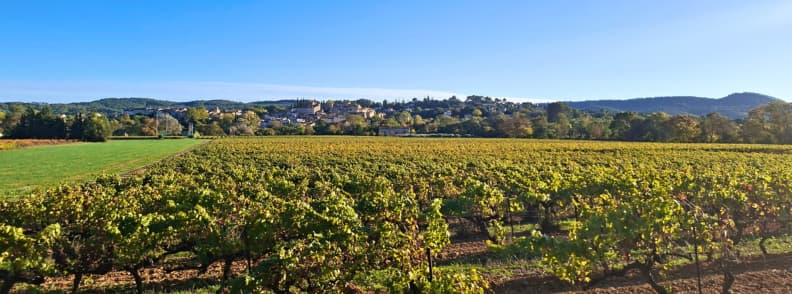
Sunday Evening Wind Down & Return via Carcès
As the afternoon faded, we packed the camper and got ready for the way back home. Leaving Cotignac France, after such a full weekend felt a little bittersweet.
The Drive through Carcès
We left Cotignac Provence, and drove through Carcès and past Thoronet Abbey, remembering the weekend we had spent in that area just a few months ago. It was the most scenic route to the highway. The drive wound between vineyards, olive groves, and small stone walls that caught the sunset. The camper moved slowly through the narrow turns, and the light shifted from gold to pink. It was a beautiful end to our Provence road trip, quiet and steady after two busy days.
Looking Back at Our Cotignac Weekend
As we drove, I kept thinking about how different Cotignac had felt from Sillans. After the “no campers” signs and blocked roads there, Cotignac’s open attitude stood out even more. It’s a place that makes space for visitors without losing its local rhythm.
I told Mathieu that we should come back for other events and stay longer next time, maybe try the hikes we couldn’t do this time. My mother-in-law and her partner had missed the Fête du Coing this year, but added it to their calendar for next October. With Willy a year older, we’ll be able to enjoy the market and the local restaurants better, maybe as an extended family group.
Our Cotignac weekend itinerary ended where it began, surrounded by the hills of Provence Verte. The short escape reminded me that the best trips aren’t the ones that go perfectly, but the ones that still feel right in the end. Cotignac did that. It turned a weekend of blocked parkings and detours into a calm, genuine memory, the kind that makes you plan your return before you even get home.
Practical Cotignac Travel Guide
Planning your Cotignac France trip is simple once you understand how the seasons and small-village logistics shape daily life here. This part of Provence Verte still follows the rhythm of markets, church bells, and warm evenings that stretch long into summer. Whether you’re visiting by car, camper, or rental van, these tips will help you plan the perfect stop in your Cotignac weekend itinerary or longer Provence road trip.
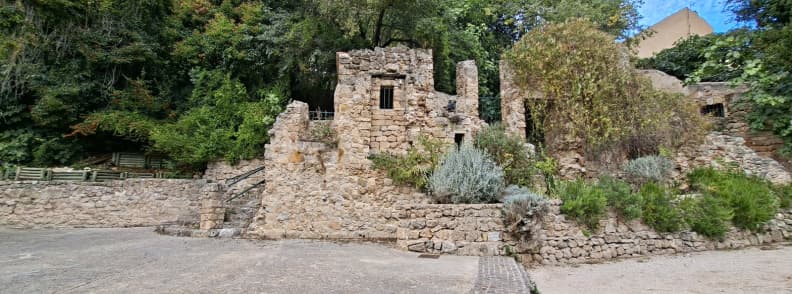
Best Time to Visit Cotignac
The best time to visit Cotignac depends on the kind of experience you want. The village has a Mediterranean climate, with hot, dry summers and mild winters. In summer, daytime temperatures can reach around 33°C, while in winter they drop to about 10°C. The most comfortable seasons are spring (April to June) and autumn (September to October), when days stay around 25°C and the markets feel lively without being crowded.
Spring in Provence is full of flowers and long market mornings that start to spill onto the terraces. This is a perfect time to explore the cliffs, trails, and surrounding vineyards without the summer heat.
Autumn markets are colorful, full of figs, grapes, and quince products, leading up to the Fête du Coing in October, one of the key Cotignac events each year.
Summer in Cotignac is the high season for festivals and nightlife. One highlight is Les Toiles du Sud, held in the Théâtre du Rocher, Cotignac’s open-air theatre built at the base of the cliff. Screenings run through July and August, turning the rock face into a natural cinema wall. Locals bring chairs, snacks, and wine, making it one of the most charming summer festivals in southern France.
Winter in Provence is quieter but still worth considering. Streets remain walkable, cafés stay open, and the cliffs look beautiful in the low light. For expats or slow travelers living nearby, winter is ideal for peaceful walks, visiting sanctuaries, and taking in the rhythm of Provence without the heat or the crowds.
Getting Around & Parking in Cotignac
Getting to and around Cotignac Provence is easiest by car. There’s no train station, and the nearest bus links through Brignoles or Aups are infrequent, especially on weekends. Driving is essential, but be prepared for narrow village lanes typical of southern France. Parking is limited in the center, though several official lots sit just outside.
Here’s a quick Cotignac parking map overview with practical notes:
- Parking 634 Lauron. Large gravel lot near the lower entrance of the village. Closed during major events such as the Fête du Coing.
- Parking by the Cotignac Tourism Office. Central and convenient, but restricted by 2 m height limits. Not suitable for vans or campers.
- 867 Chemin de la Colle. The most camper-friendly option, a fifteen-minute walk from the center. Flat enough for an overnight stay and regularly mentioned on Park4Night.
- Smaller free car parks line the approach roads into the village, though they fill quickly on Tuesday market Cotignac.
Driving gives you full flexibility to visit nearby villages like Sillans-la-Cascade, Entrecasteaux, and Carcès. If you’re doing vanlife Provence, plan your arrival before late afternoon to secure a level space, and always check for event closures. Cotignac stays welcoming to careful drivers who park respectfully, which is one more reason it stands out among Provence Verte villages.
Where to Stay in Cotignac
Finding accommodation in Cotignac varies from boutique luxury to family-friendly budget stays, so you’ll comfortably match your travel style in this guide to Cotignac hotels, villa rentals Cotignac Provence, and camping Cotignac.
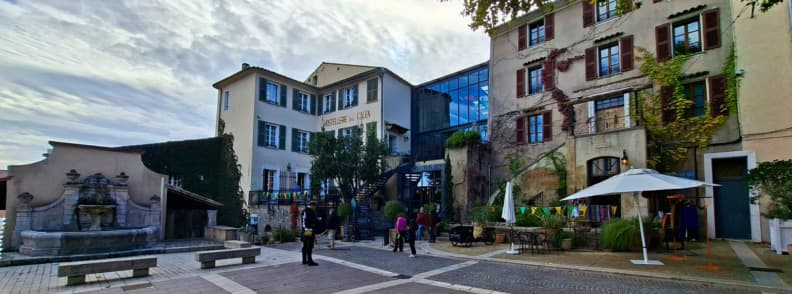
Boutique & Luxury Option
Start with Lou Calen Hotel, an eco-resort located in the heart of Cotignac on a lush estate of three hectares. With 36 rooms set among gardens or overlooking the village, an outdoor pool, and a Michelin Green Star restaurant, this property is ideal for travelers who want comfort, style, and a true village-centre location. It also supports villa rentals with pool on their estate, making it a top pick for families or groups seeking luxury near the centre.

Mid-Range / B&B Option
For a charming mid-budget choice, consider La Maison du Bonheur B&B. Just a few minutes from the village centre, it offers comfortable rooms with private bathrooms, free parking, and a friendly atmosphere. It’s a fine option for couples, small families, or expats seeking a quieter stay and easy access to the village’s cafés and lanes.
Another excellent mid-range choice is La Licorne, a boutique-style guesthouse located close to the Cours Gambetta. This Provençal property combines elegant, air-conditioned rooms with a shaded terrace and outdoor pool, creating a relaxing atmosphere that feels both central and peaceful. With easy walking distance to restaurants and markets, La Licorne Cotignac balances authenticity with modern comfort, perfect for a weekend in Cotignac.
Family & Budget Options Nearby
If you are traveling with a toddler or a camper, or you want budget flexibility, look to options within 5-10 km of Cotignac in surrounding villages like Entrecasteaux or Carcès. These locales often offer villa rentals Cotignac-region, larger family-friendly homes with pools, and sometimes camping Cotignac sites with full services, such as Camping Municipal Les Pouverels. They provide space and value while keeping you within reach of Cotignac’s charm.
Cotignac Accommodation Tip: When booking, check for family rooms, baby-bed availability, parking, and pool access. Terms like Airbnb Cotignac and villa rentals with pool may give more flexibility than standard hotels.
Where to Eat & Drink in Cotignac
Exploring food in Cotignac means choosing between rustic authenticity and refined flavours. Below are top picks across budgets that align with local life for travelers and expats.
Le Jardin Secret (Michelin Green Star)
At the heart of Cotignac Provence, you’ll find Le Jardin Secret, part of the Lou Calen estate. This restaurant has earned a Michelin Green Star for its committed seasonal kitchen, using vegetables picked at dawn, local meats, and fresh-caught fish.
The terrace sits beneath fig trees, the air scented with olive leaves. Reserve ahead if you want to splurge on Provençal cuisine that feels both local and elevated.
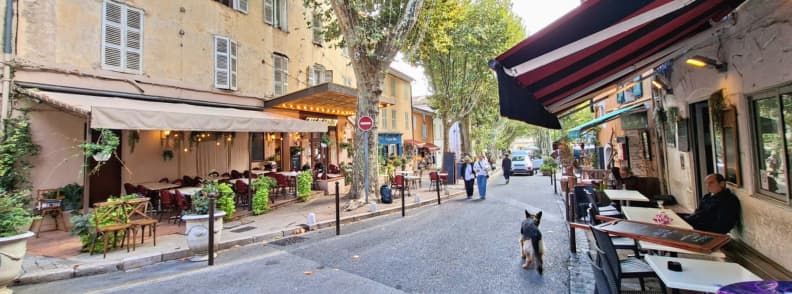
Bar Le Marigny & Café de l’Union
Bar Le Marigny sits on Cours Gambetta, right in the village centre. It’s a local favourite for coffee, aperitifs, and casual drinks, especially during events like the Fête du Coing. We stopped here several times, once for a warm vin chaud au coing, and it’s the perfect place to watch Cotignac go by.
For food, Café de l’Union nearby serves reliable Provençal classics at fair prices, ideal for lunch or a relaxed evening meal.
Le Clos des Vignes & Wine Tasting at Mirabeau Wine & Spirits
If your preference leans toward Provençal wine, stop at Mirabeau Wine & Spirits in Cotignac for a tasting session. The boutique presents premium rosés and invites discussion on terroir, grapes, and vineyard history in the region.
After your tasting, dine nearby at Le Clos des Vignes, where local wines meet regional dishes, often served on shaded terraces overlooking vineyards.
Cotignac Olive Oil Mills & Local Producers
Beyond restaurants, Cotignac’s local producers matter. Some olive oil mills open to visitors offer tasting rooms where you can sample fresh-pressed oil, herbs, and tapenades. For expats or food-loving travelers, pairing a visit here with dinner at a top table enriches the experience.
Money, Language, Packing, Connectivity
Travel in Cotignac France is straightforward and comfortable, even for first-time visitors. The village caters well to both short-term tourists and expats living in Provence Verte, so practical details like payments, communication, and connectivity rarely cause problems.
Money & payments
You don’t need to carry much cash in Cotignac. Most places accept cards, from restaurants and cafés to small market stalls and even the ticket desk at the caves. As I noticed, there’s no need for cheques. Cards are accepted everywhere, even in the caves.
The main square has a convenient ATM Var branch near the mairie if you prefer withdrawing euros. Prices are typical for rural Provence: a coffee around €2, a glass of wine €4, and a three-course meal €25-30.
Language & communication
English is widely understood in shops, restaurants, and accommodation, but using a few French phrases always helps. Simple greetings like Bonjour, Merci, and L’addition, s’il vous plaît go a long way with locals. Expats living nearby tend to mix French and English easily, so don’t worry if your French is basic. Locals appreciate any effort to speak their language.
What to Pack for Cotignac
When you pack for Cotignac, think layers. The climate shifts quickly between sun and shade, especially in spring and autumn. It’s best to pack layers in autumn so you can add or remove as needed. Comfortable shoes are essential for the cliff paths, and a light rain jacket is useful in late October. Families with young children should remember small items that make a big difference, such as a baby spoon, snacks, and extra wipes for market days.
Connectivity & mobile use
Mobile coverage is reliable across Cotignac and the surrounding valley, with good mobile signal Var on all major French networks. Most hotels, gîtes, and cafés with wifi cafés access, often without a password. Data speeds are fast enough for remote work or video calls, making the village a comfortable base for expats or digital nomads who need to stay connected while enjoying the Provençal pace of life.
Cotignac Day Trips & Nearby Villages in Provence
Cotignac France makes a perfect base for visiting Provence Verte, with scenic drives, lakes, and hilltop towns all within easy reach. The landscape shifts between vineyards, olive groves, and limestone ridges, giving you something new each day without long hours on the road. These day trips from Cotignac highlight the best of the region’s history, nature, and food traditions.
Sillans-la-Cascade, 7 km
Just fifteen minutes away, Sillans-la-Cascade waterfall is one of the most photographed sites in Provence Verte. The 42-metre-high falls drop into turquoise water surrounded by dense forest. It’s best visited early in the morning before parking areas fill. Bring walking shoes and avoid visiting after heavy rain, when access paths can be slippery.
Entrecasteaux, 12 km
Drive twenty minutes west to Entrecasteaux, a small village famous for its castle and gardens. The Château d’Entrecasteaux overlooks the Bresque River, and its symmetrical gardens, designed in the 18th century, are open to visitors. The village itself is quiet, with narrow lanes and a few cafés serving regional dishes. It’s an easy half-day trip from Cotignac Provence, ideal for history and architecture lovers.
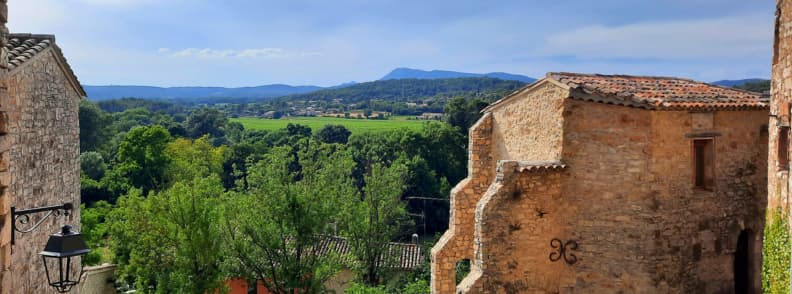
Carcès, 10 km
To the south lies Carcès, known for its lake and cooperative wine cellar. The Carcès Lake walk is peaceful, surrounded by reeds and birdlife, and the wine co-op offers tastings of local rosé and red blends at good prices. The village has a few shaded terraces where you can enjoy lunch or a coffee before continuing your Provence road trip.
Aups, 20 km
Head north to Aups, a market town with a proud truffle tradition. The Aups truffle market runs from December to March and draws chefs and locals from across the region. Outside truffle season, Aups still feels lively, with art galleries, a Friday market, and traditional Provençal restaurants serving local goat cheese and honey.
Salernes, 17 km
A short drive west brings you to Salernes, a pottery town where workshops line the streets and ceramic tiles decorate the façades. Many artisans open their studios to visitors, making it a great stop for expats interested in design or craftsmanship. Combine it with Entrecasteaux for a full day loop through villages near Cotignac.
Tourtour, 25 km
Nicknamed the village in the sky, Tourtour sits high above the valley and offers one of the best panoramic views in Provence Verte. Cobbled lanes lead to small galleries, and the central square is full of cafés. It’s ideal for a late afternoon visit when the light turns golden across the vineyards.
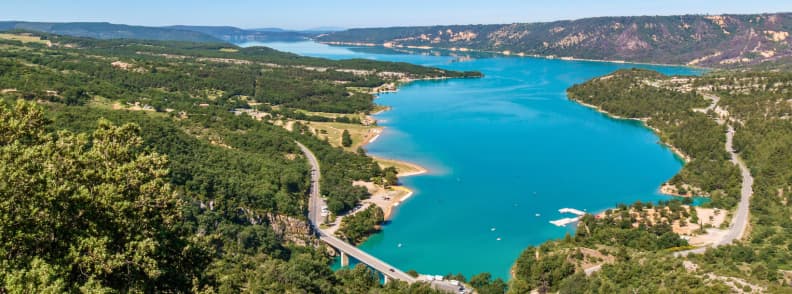
Moustiers-Sainte-Marie & Gorges du Verdon, 60 min
For a full-day adventure, drive an hour north toward the Gorges du Verdon. Stop in Moustiers-Sainte-Marie, a beautiful pottery village set beneath limestone cliffs. From there, rent a kayak at Lac de Sainte-Croix or take the panoramic Corniche road for sweeping views of the canyon. This trip combines nature, culture, and easy access back to your base in Cotignac France.
Each of these villages near Cotignac offers something distinct, whether it’s waterfalls, castles, pottery workshops, or truffle markets. Together they create a rich Provence Verte itinerary that balances relaxation with discovery, all while keeping Cotignac as your peaceful, central base.

Cotignac Guide for Camper Travelers. Real Tips from the Road
Traveling by camper in Provence Verte is rewarding, but it comes with details that only experience teaches. Cotignac France stands out as one of the scenic villages in the region that feels welcoming to vans and motorhomes, provided you plan ahead. This section gathers my honest advice from our weekend, useful for anyone doing vanlife Provence or exploring by camper Cotignac for the first time.
Driving & Parking Realities
A vehicle over seven metres is manageable in Cotignac if you avoid the narrow historic center. Most village car parks have a 2 m height limit, including the one near the Tourism Office. For campers, the best option is the quiet overnight parking at 867 Chemin de la Colle, listed on Park4Night. It’s about fifteen minutes on foot from the center, flat enough for sleeping, and free. We stayed here one night without any problems. There were no signs against overnight parking, and no one came to check.
Staying Discreet & Respectful
That weekend, a neighbor parked nearby used chocks to level his camper. We chose not to. Since it was an off-camping spot, we preferred to keep a low profile and stay parked like any other car, without chairs or tables outside. Nobody said anything to him, but when we off-camp, we follow the rule that if it looks like camping, it attracts attention. This approach keeps overnight van Cotignac stays stress-free and helps maintain good relations with locals.
Cotignac Camping Conditions & Preparation
The spot at Chemin de la Colle is quiet and convenient but basic. There are no service points in Cotignac for filling water or emptying tanks, so prepare before arrival. Bring extra drinking water and a power bank for devices if you don’t have solar panels. The nights in autumn can be windy, so pack warm layers and a good blanket. The wind can shake the camper slightly, but it’s part of the Provençal experience.
Where NOT to Go
If you plan to explore nearby, avoid Sillans-la-Cascade with a large vehicle. Almost every parking lot there is explicitly marked “no campers”. The road to the only parking for campers is narrow with a sharp turn and full of potholes. It’s easier to visit the waterfall by car once you’ve set up in Cotignac.
Cotignac Camping Tip: Always check Park4Night before arriving for updates on event closures. During the Fête du Coing, for instance, Parking Lauron was closed for the equestrian show. Arriving early in the day and keeping an eye on local signs saves a lot of trouble when traveling through the overnight parking Var network of small villages.
Cotignac remains a reliable stop for responsible vanlife Provence travelers. Treat the village with the same respect it offers visitors, and you’ll find a peaceful, scenic base surrounded by vineyards, olive groves, and some of the most generous people in southern France.
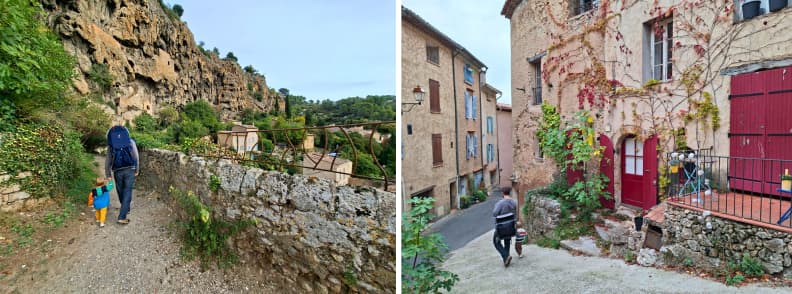
Traveling with Kids in Cotignac
Cotignac France is small enough to explore easily yet full of things that catch a child’s attention. It’s one of the most toddler friendly Provence villages we’ve visited, especially for families who travel slowly and don’t mind adjusting plans to fit naps and meals. The streets are calm, most lanes are pedestrian, and locals always seem ready to smile or stop for a chat. Here’s what helped us make family travel here simple and enjoyable.
Cotignac Stroller & Carrier Logistics
Using a stroller in Cotignac works well in the center along Cours Gambetta and the main square, where the surface is mostly flat. Once you head toward the cliffs or the Sanctuary, it’s better to switch to a baby carrier.
We kept the stroller folded for the Balade du Rocher trail and for the climb to Notre-Dame de Grâces. The stairs and cobbled paths are steep in places, and a carrier keeps your hands free.
For families traveling with more than one child, alternating between stroller and carrier makes it easy to move around without feeling limited.
Cotignac Playgrounds & Family Activities Provence
Cotignac has a few spots where kids can run around safely. During the Fête du Coing, there was a temporary kids’ area by the mairie with wooden toys and games. On regular days, the playground on the path to the sanctuary is a better option. It’s shaded, clean, and has space for toddlers to move freely. We stopped there on our way down from the sanctuary and appreciated having a calm place where Willy could play before the walk back to the camper.
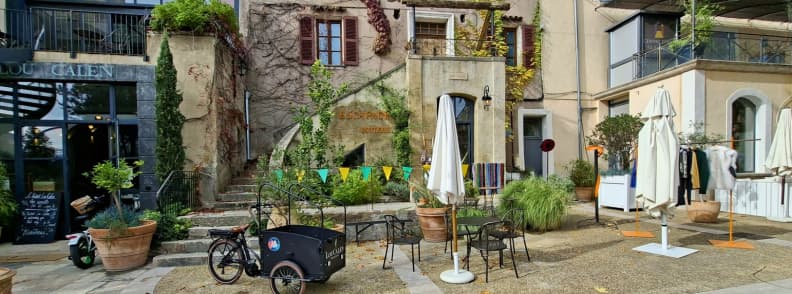
Family Rhythm & Daily Flow
Our family rhythm shaped the weekend. Willy walked most of Saturday through the village lanes, waving at locals and pointing at every dog that passed. He napped in his carrier during the sanctuary climb, which turned out to be perfect timing. When he slept, we could visit quietly and take in the view without rushing. This balance made visiting Cotignac with kids work for all of us. Family travel Provence is easier when you plan walks around naps instead of trying to keep a strict schedule.
Eating with Toddlers in Cotignac
Finding suitable meals for a toddler takes a bit of planning, especially on Sundays. Market food is often too salty or spicy for small children, and grocery shops like the village Spar stock only a few baby options that are more expensive than in hypermarkets. Bringing your own spoon and a small food kit can help a lot. We fed Willy in the camper both days, which saved time and avoided frustration.
Cotignac is a great choice for families who prefer calm, flexible days instead of packed itineraries. The setting is safe, the locals are kind, and the landscape keeps kids curious without overwhelming them. With a good baby carrier, a few snacks, and an open plan, Cotignac with kids becomes one of the most rewarding experiences in southern France.
Cotignac Culture & History Highlights
Cotignac France carries centuries of history in its cliffs, fountains, and narrow lanes. Walking through the village feels like moving between time periods, each marked by small details carved in stone or written on the plaques that guide you along the heritage walk. Below are the main cultural and historical highlights that make Cotignac one of the most authentic destinations in Provence Verte.
Cottinius Etymology & Origins
The Cotignac history begins with the Romans. The village name likely comes from a Roman officer named Cottinius or Cottinus, combined with the Latin suffix –acum, used to mark land ownership. Over time, the name evolved into Cotiniacum, then Cotignac. The area was prized for its fertile soil and water sources, which supported vineyards, olive trees, and mills for centuries.
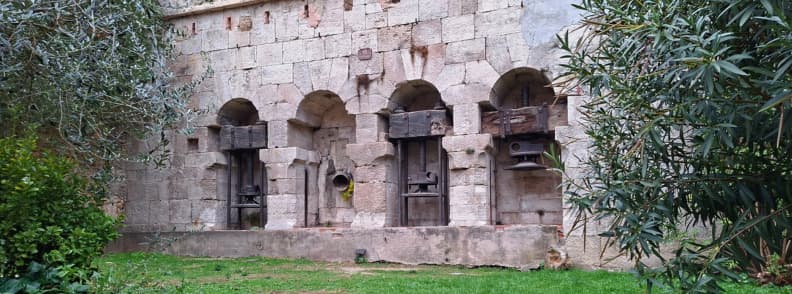
The Cassole River & Water Management
The Cassole River has always been the lifeblood of Cotignac France, shaping both its landscape and its prosperity. Long before the village took its modern form, the Cassole’s strong flow carved the limestone cliff now known as Le Rocher, forming the overhangs that later became home to troglodyte dwellings. Then, the Cassole river diversion (18th century) prevented flooding, a decisive engineering move that allowed Cotignac to expand safely below the cliff and irrigate the fertile farmland stretching across the valley.
The diverted current powered a network of oil and grain mills, whose stone channels and arches still line the shaded paths below the village. One of these, the Moulin de Piquet, stands as the last remaining mill in Cotignac, a reminder of the days when olive oil and flour sustained the local economy. The name Piquet comes from the milling tax once paid to the village lord in exchange for grinding wheat, a system that survived even after the oil mill passed to the community in 1521. Here, olives were stacked in round scourtins (woven baskets pressed in layers) to extract the precious virgin oil that flowed through stone drains into waiting basins.
By the 19th century, Cotignac counted more than a dozen mills powered by the Cassole’s diverted streams. This same water later supported the silk and tanning industries, which relied on its steady humidity, and nourished gardens of olive, fig, and vine, the enduring symbols of Cotignac’s rural rhythm and Provençal prosperity.
The diverted current powered a network of oil and grain mills, their stone channels and arches still visible along the lower paths. Over time, the Cassole’s energy supported new trades, including silk factories and tanneries, which relied on its constant flow for washing hides and maintaining humidity in the magnaneries. The same water-fed gardens filled with olive trees, fig trees, and grapevines, giving Cotignac its agricultural richness and rhythm.
In 1897, Cotignac entered a new era when it built one of the region’s first hydroelectric power stations at the base of Le Rocher. Using a system of penstocks to channel water from the Cassole into turbines, the plant produced enough electricity to light village streets and homes. Output varied with the river’s level, but the installation made Cotignac one of the earliest electrified communities in Provence.
The municipality also invested in a reliable water network. Over successive generations, Cotignac purchased springs, built underground pipelines, and installed 18 public fountains to supply clean water to every neighbourhood. Many still run today, adding their constant trickle to the soundscape of the village.
The river even shaped the local language and trades. In Provençal, naïs means basin. The Rue des Naïs, which continues from Rue des Marais, once held several basins where wheelwrights and basket makers soaked their wood to harden it. The water stood stagnant most of the year, becoming a haven for insects and tiny transparent worms that locals also called naïs, after the small freshwater creatures found in the Cassole’s shallows.
Through every era, from medieval mills to hydroelectric turbines, the Cassole River has defined Cotignac’s identity. Its water has powered industry, nurtured crops, and even lent its name to the streets, leaving behind a living heritage that still runs through the heart of Provence Verte.
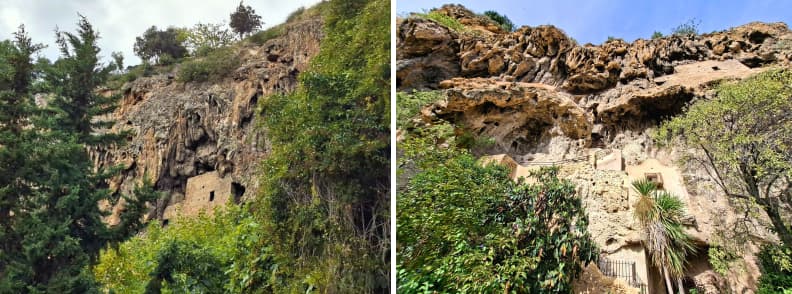
Cotignac Troglodyte Fortifications & Saracen towers
Unlike most Provençal villages that settled on hilltops for protection, Cotignac France chose an unusual position, built directly into the flanks of its Rocher. The vast tuff cliff became both a natural wall and a living foundation for the medieval village. By the 13th century, Cotignac had become a castrum, or fortified settlement, that used the rock itself as its outer defence.
Until 1785, four fortified gates controlled entry to the village: Porte de la Puade, Porte Saint-Sébastien, Porte Notre-Dame, and Porte Saint-Martin. The area known as La Puade, from the old Provençal word meaning strong smell, referred to the pigsties once kept nearby. The heart of the medieval village stood at the base of the cliff, with its southern limit near today’s Place de la Mairie, once called Place du Marché, the market square.
At the summit, the two Saracen Towers marked the upper limits of the Cotignac troglodyte fortifications. Built mostly from local tuff stone, a porous limestone formed by the slow deposit of calcium on moss and vegetation, they are unique in Provence. The material was abundant, light, and easy to carve, allowing the towers to rise directly from the cliff they guarded. The smaller tower served as a watchtower, while the larger acted as a fortress with a vaulted storage chamber at its base for supplies and weapons.
These towers had no ground-level entrance, strengthening Cotignac fortifications. Access was through an opening several metres above the ground, reached by a removable ladder that could be pulled up in case of attack. Inside, narrow slits and geminated windows (twin openings divided by a small central column) provided both light and surveillance points.
Archaeological research suggests that the towers were built between the 13th and 14th centuries, possibly replacing an earlier defensive structure from around 1032, when the first lord built his castle at the foot of the cliff to protect villagers from raids and invasions.
From the top, guards could watch both the Saint-Martin plain to the north and the valleys stretching south toward Carcès and Entrecasteaux. The site’s position gave the community a full visual command of the region, together with protection from invaders and the floods that once plagued the valley.
Few medieval remnants remain today, though a fine corbelled-arch house on Rue Clastre still shows how upper floors once extended over the street to enlarge living space. In the early 20th century, a rockfall destroyed part of the Upper City, forcing the demolition of several unsafe buildings, whose ruins now form part of the Théâtre du Rocher.
Damaged during the Wars of Religion, the Saracen towers deteriorated for centuries until they were fully restored in 1994 under the supervision of Mr. Farhner, architect of Les Bâtiments de France. Standing once more in their original grace, they remain the proud sentinels of Cotignac, silent witnesses to a thousand years of resilience, ingenuity, and life lived beneath the stone that has always protected this village.
Industry & Rural Heritage in Cotignac
By the 1800s, Cotignac France had evolved into a small but industrious village powered by water, fields, and craftsmanship. The same Cassole River that sculpted the cliffs also powered mills, irrigated gardens, and sustained the workshops that defined daily life in Provence Verte.
The Harvest Season
Before vines and olive trees came to dominate the valley, Cotignac lived from its grain harvests. From the Middle Ages until the 18th century, bread was the essential food, and cereal fields covered most of the arable land. Harvest time was the heart of village life.
Around mid-July, teams of reapers worked from sunrise to sunset. One man cut wheat with a curved sickle (oulame), while women and children gathered and tied the sheaves. The rhythm of the day was precise: a break at 9 AM for breakfast, another at 1 PM for lunch, followed by a short nap, and a final rest at 5 PM. During harvests, meat (usually rare on the table) became part of the daily meal, shared in long, communal dinners that turned hard labour into moments of togetherness.
Once the crops were gathered, came the threshing of grain. Work began only after the morning dew had dried. The threshing floors were placed where the afternoon wind could help separate straw from grain. Horses turned endlessly in circles, treading the sheaves, while workers used forks and brooms made of heather to clear the straw and collect the grain. Local accounts from the mid-19th century describe the mix of fatigue and satisfaction that marked these days, dusty, hot, and exhausting, but always shared.
Silk & Tanneries
As agriculture modernized, Cotignac entered the age of silk and tanning. The village hosted a large magnanerie, a silkworm farm that employed about forty people at its peak in the 19th and early 20th centuries. The work followed a delicate rhythm, where eggs were incubated for three weeks in warm, humid rooms kept at 24°C and 60% humidity, while workers carefully fed the worms mulberry leaves. Thousands of silkworms required hundreds of trees, and the constant cleaning of their trays created a quiet hum of daily labour.
Once spun, the cocoons were sent to the grainage facility, where male and female moths were selected for breeding. By 1900, Cotignac ranked among France’s leading producers of natural silk seeds, exporting to Europe, Africa, and Asia until synthetic fibres replaced silk in the 1950s.
Meanwhile, the tanneries of Cotignac flourished along the Rue des Marais, where a canal brought water directly into their workshops. Around ten tanneries operated here, employing about fifty workers year-round. They specialized in thick leathers used for French army boots during World War I, and later for export to Africa, Cyprus, and Singapore.
The process was long and precise. Hides were soaked in lime to remove hair, scraped clean, and immersed for months (sometimes years) in vats of tannin extracted from oak bark. The final stages of softening and dyeing used sumac leaves, a local plant prized for its natural pigment. Cotignac’s reputation for durable leather lasted until chemical treatments made traditional methods obsolete in the mid-20th century.
By the end of the 19th century, Cotignac stood as a symbol of rural innovation in Provence, balancing manual labour with early technology. Though the mills, tanneries, and silk farms have vanished, traces remain in the arches along the riverbanks and in the stories of families whose work connected the village’s fields, cliffs, and water into one living whole.
Architectural Heritage & Village Symbols
Walking through Cotignac France reveals how history is layered in its streets, façades, and squares. The village’s architecture blends Provençal charm with centuries of civic pride, from its campanile and 18 public fountains to its church, town hall, and sculpted stonework. These details tell the story of a community that has evolved with its land yet never lost its sense of place.
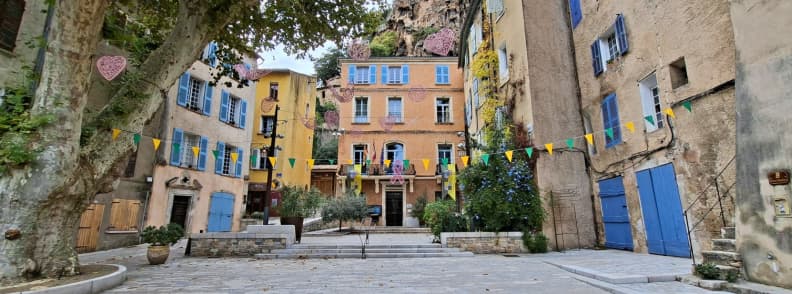
The Town Hall & Former Bakehouse
The Mairie de Cotignac occupies a 16th-century building that began as the village bakehouse. In 1555, the baker lived upstairs, but the heat from the oven made the space uninhabitable, and in 1558, the council approved its sale and conversion into a municipal office.
By 1610, the first floor housed the council chambers while the ground floor became the oil mill room, nicknamed l’école after the small classroom located on the upper level beside the archive and local court. Over time, the mairie adapted to new roles, from operating municipal turbines and early electrical systems to its most recent renovation, which preserved the original stonework while modernizing the interior.
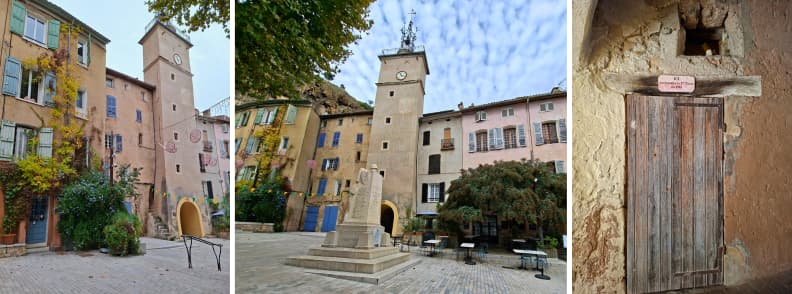
The Campanile & Sundial
Rising above the old town, the Cotignac campanile dates back to 1496. Made of open wrought iron to resist the strong mistral wind, it crowns the public clock tower with Provençal grace.
Originally, a mechanical system of pulleys and wires connected the clockwork to a hammer that struck the bell to mark the hour, a mechanism still in use today, electrified in 1963. A sundial, added in the 16th century, decorates the façade below. The earliest dials did not show numbered hours but only four lines, marking the start and end of the workday, and two for meal breaks.
Restored in 2007, the campanile remains one of the village’s proudest symbols, linking Cotignac’s daily rhythm to the Provençal sun.
Cours Gambetta
The wide Cours Gambetta, Cotignac’s main promenade, stretches along the southern side of the village. Once owned by the Prince of Condé and used for grazing, it was purchased by the town council in 1770 and planted with elm trees that were later replaced by hackberries, then by plane trees.
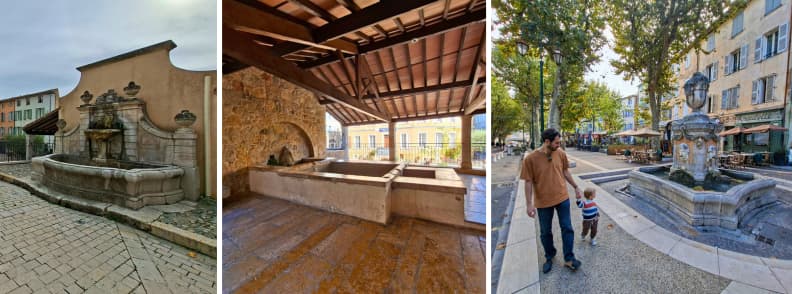
By the 19th century, it had become a bourgeois avenue lined with elegant houses, a washhouse and two fountains, namely the Cascade Fountain (1850) and the Four Seasons Fountain (installed later, though bought in 1810).
Early in the 20th century, it was home to the Cercle des Ouvriers and other social clubs, the forerunners of today’s cafés and bars where locals still gather over an apéritif under the trees.
Today, Cours Gambetta and the Place Joseph Sigaud (Place Neuve), fully restored in 2023, form the heart of village life, ideal for strolling, dining, or simply living on Provençal time.
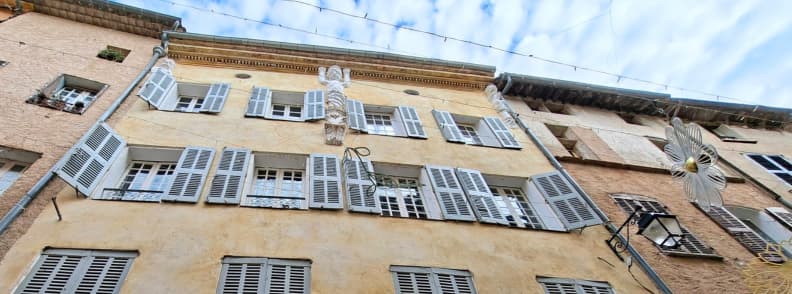
Grande Rue & the Cariatides
On the Grande Rue, a stately 17th-century house displays three Cariatides, female statues sculpted in 1623 by a wealthy landowner to signal his social standing. The figures, dressed in flowing robes and balancing the roofline on their heads, were inspired by the classical women of Caryae, in the Peloponnese. They were restored in 2013, returning their refined detail to one of Cotignac’s most photographed façades.
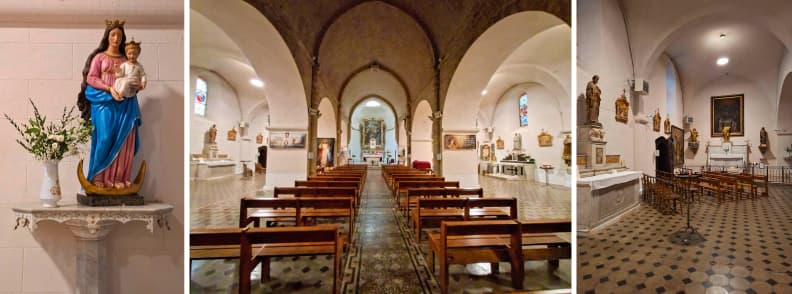
The Churches of Cotignac
Two churches shaped Cotignac’s spiritual and architectural landscape: Saint-Martin Chapel, founded in the 5th century, and the Parish Church of the Annunciation (Église Saint-Pierre), built in 1266 at the base of the cliff.
Saint-Pierre replaced earlier chapels that stood in the plains above. Expanded in the 17th and 18th centuries, it now holds an exceptional collection of registered historic furnishings: a Louis XV marble high altar attributed to Pierre Puget, a 1524 bronze bell, a 16th-century marble font, and a finely wrought 17th-century iron communion rail.
Its 19th-century organ, built by Daublaine and Callinet and restored several times (most recently in 1990-2004), fills the nave with warm, resonant sound. The church underwent a complete interior restoration in 2004, including the renewal of flooring, lighting, and heating, preserving its calm atmosphere for generations to come.
The Saint-Martin Chapel, Cotignac’s oldest religious site, dates to the 5th century and was expanded repeatedly over six hundred years. Its 14th-century frescoes still show angels and saints painted in soft earth tones. Once the village’s main place of worship, it was gradually abandoned after floods and invasions pushed residents downhill. The chapel later served as a barn, then returned to public use after 1905. Mass was celebrated there each year on Saint Martin’s Day until the 1960s, and the site remains a silent witness to the village’s earliest history.
Faith & Pilgrimages to Notre-Dame de Grâces & Saint Joseph du Bessillon
Cotignac France is known as the village of the Holy Family, the only place in the world where the Virgin Mary and Saint Joseph appeared. These apparitions in 1519 and 1660 transformed Cotignac into one of France’s most important pilgrimage sites. Today, visitors come for devotion, peace, nature, and history among the vineyards of Provence Verte.
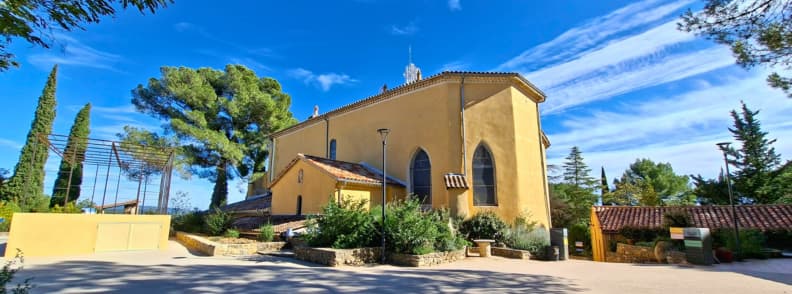
Notre-Dame de Grâces & the 1519 Apparition
On 10-11 August 1519, the Virgin Mary appeared to the woodcutter Jean de la Baume on Mont Verdaille, asking that an oratory be built in her honour. The villagers obeyed, and by 14 September, the first stone of Notre-Dame de Grâces was laid. The sanctuary soon filled with ex-votos in thanks for miracles, and in 1521, Pope Leo X granted indulgences to the site.
The Royal Connection. Louis XIII, Anne of Austria & Louis XIV
In 1637, the Virgin appeared four times to Frère Fiacre in Paris, instructing him to tell Queen Anne of Austria to pray three novenas (one to Notre-Dame de Grâces), so that she might bear an heir. Nine months later, Louis XIV was born.
In 1660, the young king and his mother visited the sanctuary to give thanks, and the Sanctuary has a set of stairs leading up the mountain that are called L’Escalier Louis XIV. The Sun King laid his blue cordon before the Virgin and authorised the transfer of Frère Fiacre’s heart to Cotignac. A royal plaque from that visit remains visible inside the shrine.
The Sanctuary Today
The church’s choir (1534) is original. The rest was rebuilt in 1811 after the French Revolution.
Inside, you’ll find the miraculous painting of the apparition to Frère Fiacre, the statue of Notre-Dame de Grâces, stained glass of the visions, and Louis XIV’s ex-voto.
The sanctuary is run by the Frères de Saint-Jean, who celebrate daily Mass and prayer, supported by the Pèlerins de Notre-Dame de Grâces Association. On-site amenities include the Foyer de la Sainte-Famille for simple meals, a pilgrim boutique, gardens, and scenic lookouts such as the Grande Croix and Belvédère pour la Vie.
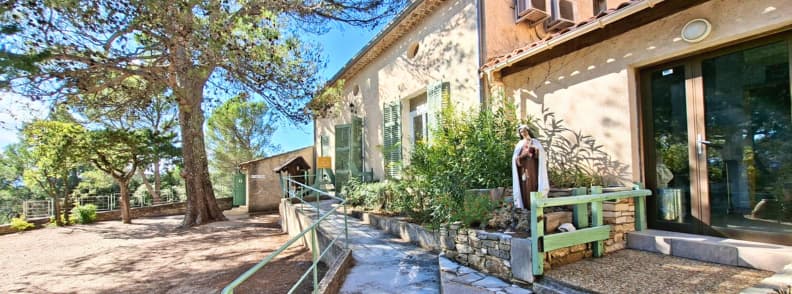
Visiting Notre-Dame de Grâces
Open year-round and free to visit, the sanctuary can be reached by car or on foot via a 2 km walking path from the village. The Escalier Louis XIV commemorates the royal pilgrimage, while the Porte de l’Aumône and Diorama Room illustrate 500 years of faith history. Families can enjoy the Baludik trail, while pilgrims follow the Chemin de Croix and Parcours des Saints through olive groves and oaks.
Saint-Joseph du Bessillon & the 1660 Apparition
In July 1660, a shepherd named Gaspard Ricard fainted from thirst in the Bessillon hills. A bearded man appeared and said I am Joseph. Lift that rock and you will drink. Water gushed from beneath it, forming the Fontaine Saint-Joseph, which continues to flow today. A small oratory was built that year, followed by a chapel consecrated in 1663, engraved with Isaiah 12:3 With joy you will draw water from the wells of salvation.
The Monastery & Pilgrim Welcome
After centuries of silence, the site was revived in 1975 by Benedictine nuns from Algeria, who rebuilt the monastery under the architect Fernand Pouillon. Since 2019, it has been cared for by the Sisters of Mater Dei from Argentina, who maintain a quiet rhythm of Mass, Adoration, and teaching. The monastery is closed to visitors, but the chapel remains open daily.
Chemin Saint-Joseph & The Holy Family Route
A 4 km pilgrimage trail, the Chemin Saint-Joseph, links Notre-Dame de Grâces with Bessillon. Six small oratories mark meditations on the life of Saint Joseph and the Holy Family. Another 9 km loop from the village passes vineyards and the Source Saint-Martin, offering a peaceful countryside walk filled with history and reflection.
A Living Pilgrimage in Provence Verte
Five centuries after the first apparition, Cotignac continues to welcome pilgrims, travelers, and curious visitors alike. Between its two sanctuaries, forest paths, and open horizons, this small Provençal village remains a place where faith and landscape intertwine, where stories of kings and shepherds still echo in the wind.
Cotignac Heritage Walk & Cultural Events
The Cotignac heritage walk connects many of these landmarks in a one-hour loop starting at the mairie. Numbered plaques explain the history behind fountains, façades, and alleyways. The route is easy to follow, and the tourism office offers a free printed map.
Beyond its monuments, Cotignac France stays lively all year with local traditions that give the village its rhythm:
- In October, the Fête du Coing fills the streets with an artisan market, live music, and a cheerful parade celebrating the quince, a fruit deeply rooted in Provençal heritage.
- During July and August, the Festival Les Toiles du Sud transforms the Théâtre du Rocher, the open-air theatre beneath the cliff, into a summer cinema. Animated films, original-language screenings, and premieres make it one of the region’s must-see cultural events.
- In December, the exposition of Provencal nativity scenes (crèches provençales) brings local craftsmanship and festive spirit to life with nativity scenes displayed throughout the village.
- Every Tuesday morning, the Cotignac market bursts with colour and scent. You’ll find stalls of lavender, honey, cheese, and fruit reflecting the unmistakable accents of Provence Verte.
Photography & Best Viewpoints Cotignac
For travelers who love photography, Cotignac France, a Village de Caractère du Var, offers a rare mix of natural drama and village detail. The cliffs, stone houses, and small squares create a setting that changes with the light. Each part of the day brings out something new, from the soft gold of sunrise on the rock face to the deep blue of twilight on the church and sanctuary. Whether you travel with a camera or a phone, this guide to Cotignac photography highlights the best spots to capture the spirit of Provence Verte.
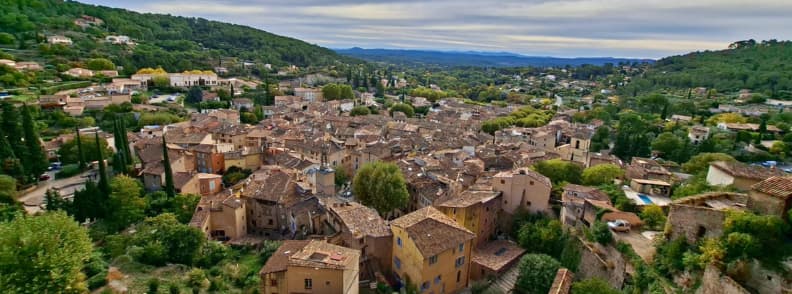
The Top of the Rocher
The top of Le Rocher Cotignac gives the most striking panorama of the village and valley. The climb takes about fifteen minutes from the centre, following the Balade du Rocher trail that winds past the caves and Saracen towers. From above, the terracotta rooftops look like a patchwork set against the pale limestone cliffs. Early morning is ideal for photos of the Rocher panorama, when the low sun lights the stone in shades of gold and pink. The path is uneven but well marked, making it one of the best viewpoints Cotignac for photographers.
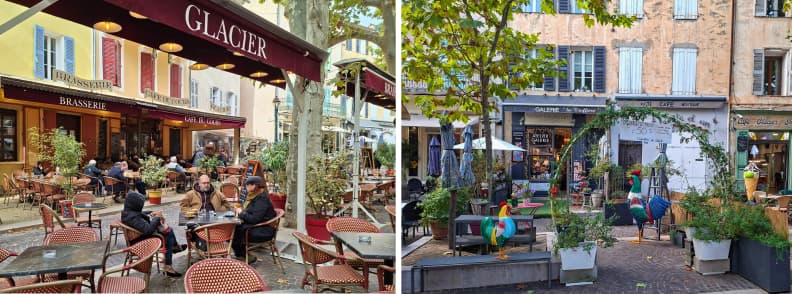
Cours Gambetta Terraces
In the heart of the village, Cours Gambetta offers a completely different view. The terraces along the cafés frame everyday Provençal life, with glasses clinking, people chatting, and children playing around the fountains. From a photography perspective, it’s perfect for candid shots and atmosphere. Late afternoon light filters through the plane trees, creating patterns on the cobblestones. These street scenes make excellent Instagram spots Provence, showing Cotignac’s rhythm beyond the obvious landscapes.
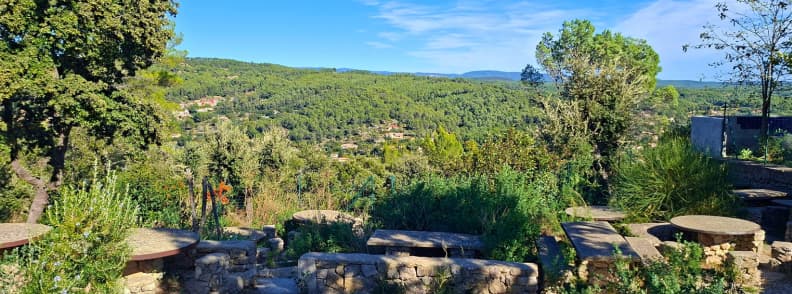
Sanctuary Views
From the Sanctuary stairs, the view back over the village is wide and peaceful. You see the roofs, the vineyards, and the cliffs rising behind them. Morning visits offer soft light, while evening brings long shadows that emphasize the shape of the valley. For a balanced shot, frame the sanctuary’s stone balustrade in the foreground. Inside, the blue ceiling tones of Notre-Dame de Grâces glow especially well under low light near sunset, giving a warm contrast to the exterior views.
Photography Cotignac Light & Timing
The Cotignac weather changes quickly, and light plays a major role in how photos turn out. Morning light paints the cliff golden and highlights the details of the houses built into the rock. Around midday, the shadows disappear, making the village streets ideal for colour shots. In the evening, the cliffs turn soft grey while the interiors of the sanctuary reflect deep blue tones, perfect for low-light photography. Patience is key. Waiting ten minutes often transforms an average shot into a perfect one.
Cotignac Photography Info: Drone use is strictly limited near religious sites, including the Notre-Dame de Grâces sanctuary and the Saint Joseph du Bessillon chapel. Always check drone rules Provence before flying, as Cotignac sits near protected zones.
Each of these best viewpoints Cotignac offers a different perspective on the village, from daily life on Cours Gambetta to the grand panorama from Le Rocher. Together, they make Cotignac one of the most photogenic small towns in southern France.
Visit Cotignac FAQ
Planning a trip to Cotignac France often brings the same practical questions from travelers and expats. Below are the most complete answers, covering everything from transportation and family logistics to weather and nearby attractions.
Is Cotignac worth visiting?
Yes. Cotignac is absolutely worth visiting for its rare combination of nature, history, and authenticity. You’ll find the impressive tuff cliff wall (400 m long, 80 m high) behind the village that houses troglodyte dwellings and towers. The weekly market, the annual Fête du Coing, and the twin sanctuaries of Notre-Dame de Grâces and Saint-Joseph du Bessillon draw visitors seeking more than just typical Provençal charm. Whether you’re staying for a weekend or relocating, the village’s welcoming pace and scenic setting make it a strong choice.
What is Cotignac known for?
Cotignac is best known for its troglodyte caves and historic cliff-walk, its longstanding Tuesday market, and the Sanctuary of Notre-Dame de Grâces, which has drawn pilgrims since 1519. The village also celebrates the annual Fête du Coing (quince festival) each October and enjoys its reputation as one of the Most Beautiful Villages of France.
Do I need a car in Cotignac?
Yes, especially for day trips and regional travel. There’s no train station in Cotignac, and local buses from Brignoles or Aups run infrequently. The village itself is walkable, but exploring nearby attractions such as Sillans-la-Cascade, Entrecasteaux, Carcès, and Aups requires driving. Renting a car is the best way to make the most of a Provence road trip itinerary that includes Cotignac.
When is the market in Cotignac?
The Cotignac market takes place every Tuesday morning year-round on Cours Gambetta and Place de la Mairie, typically from 8 AM to 1 PM. At the market in Cotignac, you’ll find local produce, cheese, and crafts. In October, the market expands for the Fête du Coing, when stalls sell everything from quince jam to liqueur. Arrive early to find parking and enjoy coffee before it gets crowded.
Is there parking for campers?
Yes, but space is limited. The most reliable option is 867 Chemin de la Colle, listed on Park4Night, where campers can stay overnight for free. It’s flat enough for a comfortable rest and about fifteen fifteen-minute’ walk from the village centre. Central car parks, such as those by the Tourism Office, have 2 m height limits, so they’re unsuitable for larger vehicles. Always check for event closures, especially during the Fête du Coing, when Parking Lauron may be used for festival activities.
Can I visit the Cotignac caves with kids?
Yes. Families can safely explore the Cotignac troglodyte caves with young children, as long as they’re supervised. Entry costs €2.50 per adult, and children enter free. The path involves stairs and narrow passages, so carriers work better than strollers. The visit takes around thirty minutes and ends with a lookout over the rooftops and valley.
Is tap water drinkable in Cotignac?
Yes. Tap water in Cotignac is safe to drink, and several public fountains are scattered around the village. Many of them date back centuries and still supply fresh, cold water. It’s an eco-friendly way to refill bottles when exploring on foot.
What should I pack in autumn to visit Provence?
Autumn in Provence brings mild days and cool evenings. Pack light layers that can adapt to quick temperature changes, a rain cover for occasional showers, and flat shoes for walking on cobblestones or trails. Families should also bring a baby spoon and toddler snacks, since local markets sell mostly adult food.
What is the nearest airport to Cotignac?
The nearest airports are Marseille Provence Airport (about 1 hour 45 minutes by car) and Nice Côte d’Azur Airport (around 2 hours). Both have car rental services and direct highway access to the Var region. For travelers based in France, Aix-en-Provence TGV station is the closest major train hub, about 90 minutes away by car.
What villages are near Cotignac?
Several charming villages near Cotignac make excellent day trips. Visit Sillans-la-Cascade for its 42-metre waterfall, Entrecasteaux for its castle and gardens, Carcès for its lake and wine cooperative, and Aups for its winter truffle market. You can also explore Salernes, known for pottery, Tourtour, the village in the sky, and Moustiers-Sainte-Marie, the gateway to the Gorges du Verdon and Lac de Sainte-Croix. Each is within an hour’s drive, making Cotignac an ideal base for exploring Provence Verte.
Why Visiting Cotignac Stays with You
Cotignac France is one of those places that works its way under your skin slowly. You don’t fall for it because of a single sight or restaurant, but because of how it feels when the crowds fade and the village breathes at last. There is a rhythm here that matches the idea of Provence slow travel. Mornings that start with the smell of coffee on Cours Gambetta, afternoons that stretch into soft golden light under the cliffs, and evenings when the air cools just enough to make a walk feel perfect.
What lingers most is how the place behaves. The weekend in Cotignac that began with blocked roads and detours ended in quiet satisfaction, the kind you only find when plans fall apart but the experience still feels right. We came for a short break, yet left with the sense that we had brushed against the real Provence that’s generous, a bit stubborn, and still ruled by its seasons rather than schedules.
Cotignac is alive in the most grounded way. It’s a village that welcomes you without putting on a show, where the same people who sell you fruit at the market wave at you later from a café table. It’s the type of place that makes travelers and expats stay longer than planned, drawn by the pace and honesty of daily life. Cotignac is the Provence you dream about, the one that’s alive, imperfect, and kind to those who linger.
If you’ve been here before, share what stayed with you. And if you haven’t yet, plan that visit to Cotignac France soon. Come for the weekend, stay for the feeling, and let the cliffs, markets, and warmth of the people remind you why Provence still matters.
About the Author

I’m Mirela Letailleur, a Provence-based travel writer from Romania, creator of The Travel Bunny, where I share firsthand cultural, family, and slow-travel experiences across Europe. I’ve lived in the Var region of southern France for years and have explored every corner of Provence Verte, often by camper with my husband and son. My itineraries mix practicality with authenticity, from navigating small-village parkings to finding the best local festivals and family-friendly trails. As a long-term expat in France, I write guides that help travelers experience Provence as locals do, balancing curiosity, logistics, and cultural respect.
Cotignac holds a special place in my heart. I’ve visited it as both a mother and a travel professional, drawn by its troglodyte cliff dwellings, the Fête du Coing, and its deep pilgrimage heritage. My expertise blends local insight with on-the-ground research, and every recommendation in this Cotignac travel guide comes from personal experience. Whether you’re a cultural traveler, a camper van explorer, or a family on a Provence road trip, I’ll help you plan an authentic visit to Cotignac France, one of the most beautiful villages in France and the spiritual heart of Provence Verte.
After planning your visit to Cotignac Provence, check out these other guides on The Travel Bunny
Bagnols-en-Forêt. Discovering the Hidden Charm of Provence
Life in a French Village. The Realities of Moving to the South of France
Train des Pignes à Vapeur. Best Steam Train Journey in France

